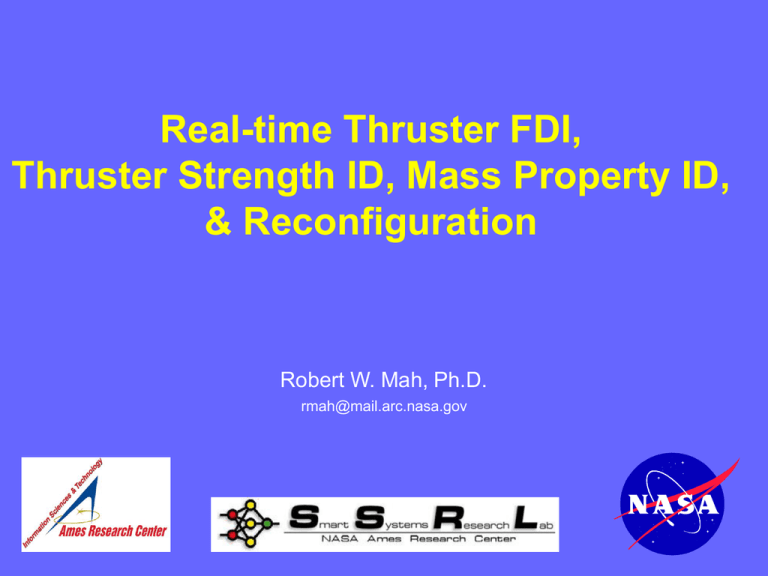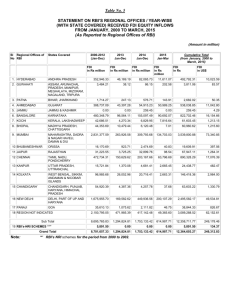Real-time Thruster FDI, Thruster Strength ID, Mass Property ID, & Reconfiguration
advertisement

Real-time Thruster FDI, Thruster Strength ID, Mass Property ID, & Reconfiguration Robert W. Mah, Ph.D. rmah@mail.arc.nasa.gov Real-time Thruster FDI Gyro-based maximum-likelihood thruster fault detection and identification Edward Wilson, Chris Lages, Robert Mah ed.wilson@intellization.com chris.lages@intellization.com rmah@mail.arc.nasa.gov Research objective: For thruster-controlled spacecraft, increase thruster fault tolerance using existing navigation sensors (a software-only solution). Develop and validate through application on realistic simulations and hardware. Outline: • Introduction • X-38 application • Maximum-likelihood FDI Demo • FDI R Demo • Conclusions 0.4 0.2 [deg/sec 2] 0 -0.2 -0.4 adisturbing-roll adisturbing-pitch adisturbing-yaw 'adisturbing,1-roll' 'adisturbing,1-pitch' 'adisturbing,1-yaw' -0.6 -0.8 -1 2 4 6 8 10 12 time [seconds] 14 16 18 20 Introduction • Spacecraft thrusters – on/off, failure modes • Sensor-based FDI uses temperature, pressure, electrical sensors – increased mass, cost, complexity • Motion-based FDI (Demo 1) most applicable for small, maneuvering spacecraft (vs. human-rated) • FDI R by switching to backup or reconfiguring control (Demo 2) • Compared with existing body of FDI, presence of on/off actuators a problem • Related research: Deyst and Deckert, 1976, Lee and Brown 1998, Wilson and Rock 1995 X-38 application overview video X-38 problem definition • Failure modes: – – – – Single- and multiple-jet Abrupt, hard Failed-on or failed-off DPS RCS and Axial • Sensors: Honeywell ring laser gyros (SIGI) • Thrusters: Mono-propellant hydrazine, blowdown, RCS (106N), axial (500N) • FDI: – Detect within 5 seconds – Limited thruster excitation permitted • Approach: – Test in simulation – Generic as possible – applicable to other spacecraft Thruster FDI approaches taken • Recursive Least Squares (RLS) – Simultaneously ID all thruster strengths, declare failure when out of spec. • Targeted RLS – One RLS process running for each thruster. • Bank of Kalman Filters – One (steady state) KF running for each failure mode, examine residuals. • Maximum Likelihood – Determine the failure mode whose resulting accelerations most closely match the measured angular accelerations • Challenge is optimizing response time while maintaining accuracy. • Difficulties presented by low SNR and biases – exceptionally challenging for X-38, as compared to MiniAERCam, S4, Stanford Free-Flying Robot Maximum Likelihood FDI • Algorithm’s core based on a 1976 paper by Deyst and Deckert on leak detection for the Space Shuttle Orbiter • Calculates difference between expected and actual angular acceleration • Compares this “disturbing acceleration” to that corresponding to the possible failure modes • Due to low SNR and failure modes with similar disturbing accelerations, filtering and windowing data required • Detection based upon generalized likelihood ratio (GLR) test for each failure mode • Identification based on the likelihood calculation for each failure mode • Excitation of thrusters required in some cases • Logic to disregard some failures, select correct failure mode Performance • Generally detects failure within 1 second (active time) for X-38, faster for Mini-AERCam • ID follows within 1-5 seconds for X-38 (slower when blowdown multiplier low) • FDI developed on X-38, then easily “ported” to Mini-AERCam and S4. Significantly easier problem due to better SNR and fewer, less complex failure modes. • Extended automatic testing run for X-38 – 99.98% accurate FDI (without miss or incorrect ID) • MATLAB demo Fault Detection Identification (FDI) X-38 FDI Demo OpenGL visualization linked to MATLAB • Uses RBNB Data Turbine to communicate between MATLAB and the OpenGL application • Asynchronous • Can run on separate computers over network Fault Detection Isolation & Reconfiguration (FDIR) Shuttle Docking Demo Extensions, continuing work • • • • • Use of translational accelerometers On-line mass-property ID On-line thruster bias ID Integration of on-line ID with FDI Implementation on air-bearing vehicle – Same MATLAB code runs on X-38 sim, MiniAERCam sim, S4 sim, S4 hardware • Standing by for X-38, Mini-AERCam programs Conclusions • Maximum-likelihood-based FDI presented for thruster fault detection. • Allows thruster FDI using (existing) navigational sensors – gyros, accelerometers, etc. • Generic algorithm applied to 3 vehicles in simulation, 1 in laboratory hardware • Enables software-only FDI • FDI R by switching to backup or reconfiguring control Acknowledgements • Funded by NASA Headquarters, HQ AA, PWC 349-00: William Readdy and Gary Martin • Problem definition from NASA JSC: Rodolfo Gonzalez, Dr. Steven Fredrickson, Tim Straube, Dave Hammen • NASA Ames SSRL members help on 3D visualization: Richard Papasin, Alan Gasperini, Rommel Del Mundo • QSS Group Inc.






